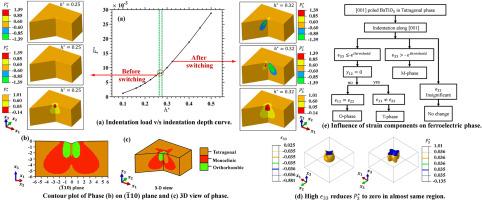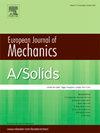基于相场本构理论的BaTiO3单晶压痕三维有限元模拟
IF 4.2
2区 工程技术
Q1 MECHANICS
引用次数: 0
摘要
对BaTiO3单晶的压痕实验表明,压痕表面的畴切换和相变是由法向或周向法向应力引起的。然而,压痕诱导相变的基本机制尚不清楚。虽然实验提供了一些关于压痕表面相变的见解,但从这些实验中很难理解压痕下相变的性质。因此,BaTiO3中压痕诱导相变的机制仍然没有得到很好的理解。因此,采用基于相场的本构模型对[001]极化BaTiO3单晶的压痕进行了三维有限元模拟。结果表明,沿压痕方向(ϵ33)的压缩法向应变必须大于四方(T)到正交(O)或T到T相变的阈值水平。此外,如果面内剪切应变(γ - 12)显著,且面内法向应变相同(ϵ11 = ϵ22),则发生T-to-O相变,否则发生T-to-T相变。相反,如果ϵ33不够压缩,T相转变为单斜相(M)。研究还表明,在受压痕影响的区域的某一点上,自发应变必须超过与该阶段发展相关的阈值水平。但如果不满足这一条件,则会在压痕影响区形成M相。本文章由计算机程序翻译,如有差异,请以英文原文为准。

3-D finite element simulations of indentation on BaTiO3 single crystal using phase-field based constitutive theory
Indentation experiments on BaTiO3 single crystals have shown domain switching and phase transformation on the indented surface, which have been attributed to normal or circumferential normal stresses. However, the underlying mechanics of indentation-induced phase transformation is not well understood. Though experiments have provided some insights on the phase transformation over the indented surface, but it is very difficult to understand the nature of phase transformation beneath the indenter from these experiments. Thus, the mechanics of indentation-induced phase transformation in BaTiO3 is still not well understood. Therefore, 3-D finite element (FE) simulations of indentation are performed on [001] poled BaTiO3 single crystals by employing a phase-field based constitutive model. Results show that compressive normal strain along the indentation direction () must increase beyond a threshold level for tetragonal (T) to orthorhombic (O) or T-to-T phase transformation. Further, if in-plane shear strain () is significant, and in-plane normal strains are identical ( = ), then T-to-O transformation would occur, otherwise, T-to-T phase transformation takes place. By contrast, T phase transitions to monoclinic (M) phase if is not compressive enough. It has also been shown that spontaneous strains at a point in the indentation-affected region must reach beyond a threshold level associated with a particular phase for that phase to develop. However, if this condition is unsatisfied, the M phase will develop in the indentation affected zone.
求助全文
通过发布文献求助,成功后即可免费获取论文全文。
去求助
来源期刊
CiteScore
7.00
自引率
7.30%
发文量
275
审稿时长
48 days
期刊介绍:
The European Journal of Mechanics endash; A/Solids continues to publish articles in English in all areas of Solid Mechanics from the physical and mathematical basis to materials engineering, technological applications and methods of modern computational mechanics, both pure and applied research.

 求助内容:
求助内容: 应助结果提醒方式:
应助结果提醒方式:


